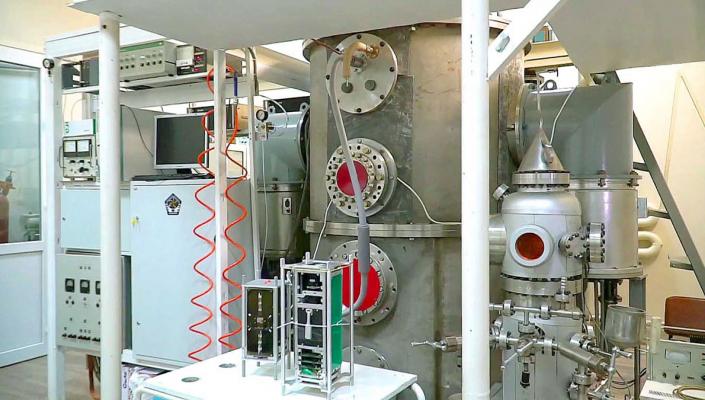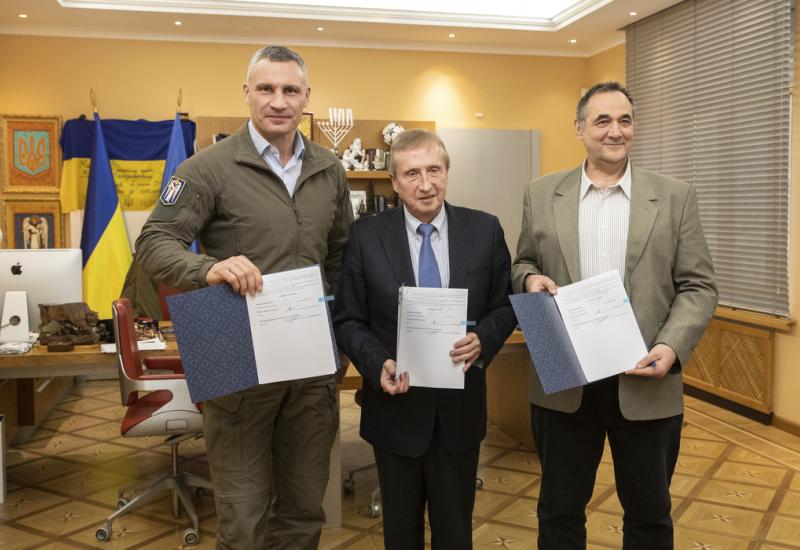For Kyiv polytechnics, space is attainable!Kyiv Polytechnic: the way to space
This 28th of January, the first and only cosmonaut of independent Ukraine, Leonid Kadenyuk, would have turned 70. This figure is significant for the Ukrainian space history. In 1997, Leonid Kadenyuk made a space flight as a member of the international crew aboard NASA’s Columbia spacecraft. The Ukrainian cosmonaut took on the role of a research biologist on this expedition: he explored the effect of weightlessness on growth and development of plants. For Ukraine, the flight of Leonid Kadenyuk was a real breakthrough and convincing proof that we have the right to call ourselves a space-faring nation.
In addition to space flight, Leonid Kadenyuk became distinctive due to his participation in aerospace systems designing and testing. As a 1st class research pilot, he mastered piloting and tested fifty types of aircraft, wrote five scientific papers, was an aeronautics and space non-staff advisor to the President of Ukraine Leonid Kuchma, and an aeronautics and space adviser to the Prime Minister of Ukraine in 2011.
And what is more, Leonid Kadenyuk was directly related to the KPI: he was Deputy Chairman of the Supervisory Board of the University, Honorary Doctor of the Faculty of Aviation and Space Systems, Advisor to the Rector, and he actively contributed to the training of aerospace specialists …
Today, the State Space Agency is engaged in the Ukrainian space program, and the National Technical University “Igor Sikorsky Kyiv Polytechnic Institute” is engaged in the development of space technology and training engineers for the space industry on the largest scale in the country.
The first Ukrainian nanosatellites
Initially, the polytechnics themselves did not really believe that their University, albeit the best among Ukrainian technical universities, would be able to create a nanosatellite on its own. And now there are five of them in KPI: two have already been launched, and three more are at different development stages.
All KPI nanosatellites are of CubeSat format, their size is of 10x10x10 cm and the mass does not exceed 1.33 kg. It is acceptable to combine up to 6 cubic units in one satellite of such format. In terms of characteristics, they are in no way inferior to their large-sized predecessors, but they significantly reduce the cost of launching into a near-earth orbit and practically do not cause the accumulation of “space debris”. These features explain the global trend in space exploration based on CubeSat.
“A small box weighing only up to a kilogram can perform all functions of a large satellite. That is, it can self-orientate in space, as well as receive and transmit data”, – Yevgeniy Kovalenko, nanosatellites designing engineer, explains the principle of operation.
The first University nanosatellite, PolyITAN-1, was launched into low-earth orbit back in 2014. It turned out to be a long-liver: it still transmits signals to the Earth. It was designed by students and researchers of six faculties and institutes of the KPI. They joined the global trend in ultra-small spacecraft development for space exploration in 2009. The principal mission of PolyITAN-1 consisted in testing the satellite and subsystems functioning in the outer space, their interaction, and working out the most important commands. 5 years later, PolyITAN-1 together with three dozen university satellites from 17 countries, successfully entered the low-earth orbit.
“Faculty of Heat and Power – a frame structure and temperature control means. Faculty of Radio Engineering – a system for transmitting and receiving information. The Institute of Telecommunication Systems – a teleport for receiving and transmitting information. Solar Photovoltaic and Test Chambers – it is the Faculty of Electrical Power and Automation”, – says Michael Ilchenko, Space Program Director, Vice-Rector of Igor Sikorsky KPI (1988-2019), Academician of the National Academy of Sciences of Ukraine.
The designers gave the satellite a maximum of one year of life in space. However, it is in the orbit for 7 years. PolyITAN-1 became the record holder. None of the three dozen satellites of other countries have lasted so long in space.
The success of the first PolyITAN was the impetus for new scientific projects. At KPI, work has begun on the second apparatus. PolyITAN-2 that was twice as large and heavy as its predecessor, entered its orbit from the International Space Station as part of QB50 project, having its own scientific mission. PolyITAN-2 was a payload international project. It was launched to measure the atomic oxygen concentration in the thermosphere – a layer of the atmosphere, whose lower boundary begins at an altitude of 80 – 90 km, and the upper reaches 400 – 800 km.
Predict earthquakes and tsunamis from space
The satellite fully completed its mission, and then the scientists of Kyiv Polytechnic took up the third CubeSat, PolyITAN-3, intended for Earth remote sensing, environmental monitoring, earthquake prediction and ionospheric research. The satellite engineering model is currently undergoing a series of tests.
“The third PolyITAN will transmit images of the Earth and download the data to us. The satellite is different in that it will have an additional unit and an installed camera, as well as extended solar panels in order to increase the satellite’s power supply”, – explains Ivan Starovit, nanosatellites designing engineer.
Scientists from Poznan Polytechnic (Poland) have joined the project – in terms of developing certain electronic subsystems. It is planned to launch the device into space orbit in 2021.
At the same time, the designers work on the fourth PolyITAN, whose main task will consist in conducting biological experiments in order to elaborate technologies for growing food for astronauts during the flight. This project is realized jointly with the Institute of Botany of the National Academy of Sciences. “The fourth satellite “BioSat” is designed with the purpose to grow high plants that can be used in long-distance space projects, in particular, for Ukraine’s lunar programs, and, possibly, international programs. The project is unique, so it is recognized by space agencies not only in Ukraine, but also in Spain and China.” – Borys Rassamakin, nanosatellites project design manager, shares the plans.
The fifth KPI nanosatellite, GraviSat, will investigate the Earth’s electromagnetic fields, as well as characteristics of terrestrial cataclysms – earthquakes or tsunamis. The unique equipment for space research developed by scientists will save millions of lives on Earth, as it will be possible to predict an earthquake 24 hours before it starts. On the basis of GraviSat, it is planned to create devices intended for far interplanetary space studies. The satellite will be able to remotely measure comet’s mass.
The successful launch and development of nanosatellites became possible thanks to the unique University material and technical base. For testing small-size spacecraft, KPI organized a special laboratory with unique chambers that fully simulate cosmic darkness, cold and vacuum.
KPI and its microsatellites
Fellows of the SHTORM Design Bureau (KPI) design satellites that belong to the micro class. Microsatellites are special-purpose spacecraft weighing about 100 kilograms The KPI project is to create a formation of 6 to 8 microsatellites, which, being simultaneously in the near-earth orbit at an altitude of 600 km, would carry out remote sensing of the Earth with a resolution of 0.5 m. Such a top result is provided by an optical scanner; both the housing of the satellite and the scanner itself are made of an ultra-strong, ultra-lightweight and high-temperature ceramic material. Its authors are also designers from KPI. Yevgen Solodkyy, Senior research fellow at Igor Sikorsky KPI, is convinced that there is no better material than ceramics for such purposes: “Ceramics are relatively light compared to metallic materials. Therefore, ceramic structures can be 3 – 4 times lighter, which significantly increases the useful weight of the aircraft. And we know that the launch price is determined per 1 kg of equipment. Ceramics are capable of operating in space. There are alternating temperature loads, and ceramics have a low coefficient of thermal expansion.”
It is planned to use similar formations of satellites for remote sensing of the Earth, for civil and defense purposes.
Own satellites reveal a wide range of possibilities. For example, KPI scientists have developed their own version of the Internet of Things. The system will work by distributing the payload of one satellite between the groups of micro and nanosatellites of the CubeSat format. It means that the owner can control his smart house from anywhere in the world. The system will function thanks to the so-called gateways that will tie a space signal to a ground one. Sergiy Kapshtyk, Assistant Head of the National Center for Space Systems Control and Testing, Associate Professor at the Department of Telecommunications of Telecommunications Institute, Igor Sikorsky KPI, says that the ideology of a furcated satellite makes it possible to place telecommunication facilities in orbit, and also to deploy a network of computing satellites: “It is our innovation, we shall place many computers in the orbit which will work like an extensive computer network located in space. Taking into account that this network is very close to a user, it takes only 10 to 20 ms to transmit a signal from the Earth to such a satellite – and then your device has access to the computer facilities”.
For over 20 years, under the leadership of KPI Professor Fedir Dubrovka, we develop unique terrestrial antenna complexes of satellite information systems for the whole world. After all, high-speed transmission of large bulk of data from a satellite to the Earth is the lion’s share of the remote sensing success. In the laboratories of the Institute of Telecommunication Systems, the researchers work on a monopulse communication system intended for this purpose.
Fedir Dubrovka, Head of the Department of Theoretical Basics of Radioengineering at Igor Sikorsky KPI, is especially proud of the invention of University researchers – a log-periodic antenna: “In fact, this is invention No. 1 in Ukraine. It differs from the known technical solutions in that it is made of a single sheet of metal, hence, the contact between the vibrators is absolutely reliable. This antenna is very practical, over 50,000 units were manufactured during recent 10 years and there were no claims. We have designed and put into operation a large reflector antenna system – a multi-beam earth station measuring 16 meters by 7 meters. It’s like a 5-storey building.”
Success of KPI in the international space mission
The whole world watched as the capsule with soil samples from the asteroid Ryugu landed on Earth. This event can radically change the idea of humanity about the origin of life. And it would be impossible without the KPI engineers. Our researchers designed a system of heat pipes, thanks to which the MASCOT spacecraft could cover 3 billion kilometers in 3.5 years since 2014 and successfully landed on the asteroid in October 2018. Volodymyr Kravets, Professor at the Department of Nuclear Power Plants and Engineering Thermal Physics of Igor Sikorsky KPI, recalls how scientists got to work on MASCOT: “The Belgians and the Spaniards were unable to make the needed construction for a year. They tried to do it, but it didn’t work. Then we began to design internal capillary structures, selected the necessary coolants, and when we succeeded, the organizers of the project immediately set about making flight samples.”
The Kyiv Polytechnic collaborates closely with the “Pivdenne” Design Bureau, the leading enterprise of the space industry in Ukraine, it occupies one of the leading positions in the world space market and participates in the implementation of NASA projects.
This year KPI plans to take part in the ambitious research and innovative program of the EU – Horizon Europe project. Such issues as smart cities, adaptation to climate changes, improving people’s health are among the principal goals of the new project. They have something in common with the research carried out by the Kyiv Polytechnics, therefore the gained experience gives many advantages to the KPI. Sergiy Shukayev, Head of the Department of International Project Coordination at Igor Sikorsky KPI, says that the key to the KPI success in this program was the more favorable conditions that the University could offer to the consortium of European universities, in which it had already worked: “KPI has specialists in almost all branches. Therefore, we prepare new projects with this consortium. But this is a competition, and you cannot always win. One of the ideas of this project is to give impetus to the development of relations between Ukrainian business and European business.”
KPI will continue to carry out large-scale space research as part of international and national projects, explore the limitless possibilities of space for the benefit of humanity and our country.
More details about KPI space projects can be found in the film “KPI. Conquest of Space”:
Michael Zgurovsky, Rector of the National Technical University of Ukraine “Igor Sikorsky Kyiv Polytechnic Institute”, Academician of the National Academy of Sciences of Ukraine




